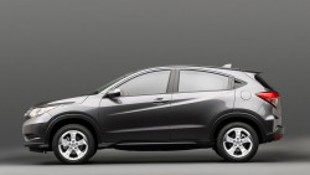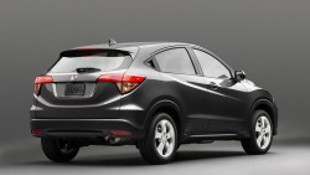What a colossal missed opportunity to not be calling this latest Honda crossover the “Crossfit.” I mean, it's a Fit-based crossover. Cross-Fit. Crossfit! [Perhaps the taint of Crosstour is just too fresh in their minds… –Ed.] C'mon Honda – enough with the alphanumerics!
Not to mention that, not unlike the aforementioned fitness craze, this little compact crossover appears to be extremely flexible, perhaps not a specialist in one particular area, but a multi-dimensional athlete. Cargo space is better than the Fit, rating 688 L behind the rear seats and 1,665 with them folded down, and the HR-V benefits from the same flexible “Magic Seat” layout that Honda's smallest car uses to great effect.
Poor weather performance should be decent, as the HR-V has available all-wheel drive and slightly raised ground clearance. There's a six-speed manual on offer in the two-wheel-drive version, whereas opting for the CVT opens up the possibility of all-wheel-drive. A little extra punch from a 1.8L four-cylinder engine means a fully laden HR-V shouldn't be too slow on a ski trip, with power ratings coming in at 138 hp at 6,500 rpm and 127 lb-ft at 4,300 rpm.
Rearward visibility isn't great, but that's almost a hallmark of any compact crossover. Interior space is pretty good, very slightly larger than the Fit, and the seats feel comfortable. The dash layout is essentially the same as throughout the rest of the Honda range, which means top models come with a slick seven-inch touchscreen-based interface – which we really wish still had an old-fashioned volume knob.
The usual suite of Honda safety features are also on offer, including the LaneWatch blind-spot camera, forward collision and lane departure warning. Higher trims will get satellite navigation, push-button start, and a power sunroof.
However, there is an essential goodness to the basic model of this car that many Honda fans will like. In many ways, it puts me in mind of the old Civic Wagon of the 1980s – we're not likely to see a Civic hatchback anytime soon, but here's a flexible and capable little Honda with clever folding seats and a bit more oomph to handle cargo-hauling duties. The slightly higher driving position will please most urban drivers, even if the rear visibility doesn't, and if it puts out Civic-like fuel economy figures, it'll make for a multi-talented do-everything sort of car. One that should really be called the Crossfit.
The following was originally published on July 29, 2014
Preview by Andy Lin, photos courtesy Honda
For nearly two decades, the Honda CR-V has been a compact SUV stalwart, attracting suburban shoppers who will brave the occasional snowbank to haul a bookcase, floor lamp and bag of meatballs from IKEA. When the HR-V launches this winter, Honda will be taking aim at city-dwellers and young families shopping in the lucrative (and very crowded) "something bigger than a hatchback" segment.
The HR-V began life as the "Urban SUV Concept" revealed at the 2013 Detroit Auto Show, which was followed up by a confirmation at the 2014 New York Auto Show in April of this year. It has yet to be shown off "in the paint"; however, it is already available in Japan, under the name Vezel (a play on "vehicle" and "bezel"). Until more concrete details emerge closer to the official North American launch of the HR-V, the Japanese Vezel offers the best glimpse of what is to come.
Though based on the Fit platform, Honda slots the Vezel next to the CR-V. If a visual comparison isn't enough, the North American nomenclature makes this association clear. It's intended as an entry-level SUV, and Japanese marketing materials claims that it "fuses the strength of a SUV with the beauty of a coupe." Hmm. Considering that the same engine that powers the Fit is being called on to drive a vehicle that is 100–200 kg heavier (a 12–17 percent difference), perhaps they're referring to other SUV strengths, such as the ride height and... well, that's really the only thing that drivers gain in comparison to the Fit – despite the difference in exterior dimensions, interior dimensions are roughly equivalent between the two models (based on Japanese figures, which I'm not quoting here since they're different from the North American versions).
Keep in mind the HR-V is being billed as an "Urban SUV", so outright performance is being traded for better fuel economy and maneuverability. Also, the engine in question here is the new Earth Dreams 1.5L I4, which offers 130 hp @ 6,600 rpm and 114 lb-ft @ 4,600 rpm, compared to the 117 hp @ 6,600 rpm and 106 lb-ft @ 4,800 in the current Fit. That is, if Honda keeps the same engine, and we believe they will – the next engine up in terms of output is the 1.8L in the Civic, and it's unlikely that the boost in performance will be justified by the increase in fuel consumption. The Vezel is CVT-only, in FWD and AWD variants. For the HR-V, however, we're expecting a six-speed manual in addition to the CVT, similar to the 2015 Fit.
In terms of design and styling, the HR-V is a winner by all accounts. It's got smooth, sculpted curves that give it character without looking too fussy. The rear door handle is built into the pillar beside the window, giving the appearance of a SUV-coupe (soup?). Reviewers in Japan noted that though the rear pillars are quite chunky, as tends to the case these days, sight lines are good due to the angle of the pillar. The taller ride height improves visibility and gives a sense of security, but it's not so high as to impact ease of entry.
Based on pictures of the Japanese Vezel, the interior design resembles the new North American Civic, simplified to make best use of the cabin space. Common elements include a touchscreen interface that's tilted to face the driver, as well as a tall centre console with deep cupholders and storage. Nothing is confirmed for the HR-V, but we're expecting it to resemble the all-new 2015 Fit which is launching this summer. Perhaps the biggest differentiating factor for this segment is the rear leg room, which benefits from the "centre tank layout", which places the fuel tank underneath the front seats. And of course, the Magic Seat system from the Fit makes an appearance here.
On paper, the HR-V fills a logical niche within the Honda vehicle lineup. But it's wading into treacherous waters with some very strong competition, not the least of which is its own stablemate, the Fit. Its most direct threats are the Chevrolet Trax, Ford Escape, and Nissan Juke, which are all priced around $20,000. Once trim levels and options are factored in, that figure may float dangerously close to some larger crossovers, such as the Chevrolet Equinox, VW Tiguan, Toyota RAV4, and of course the CR-V.
The compact crossover has been described as "a Fit with a lift kit", and that's something borne out in the specs. Of course, if automotive purchases were based on numbers alone, everyone would either be driving a Volt or a Hellcat. Although I've given short shrift to ride height and overall styling, these two points alone may be enough to sway buyers to the HR-V. After all, a vehicle is something you're looking at or looking out of. It's interesting that Honda is launching the HR-V in the winter, since it'll be right on schedule to make a connection with drivers who are looking for a little extra security out on the slushy roads. Only time will tell if their gamble pays off, but even if we're being flippant, it's easy enough to market the HR-V as "the SUV that fits your life."






















